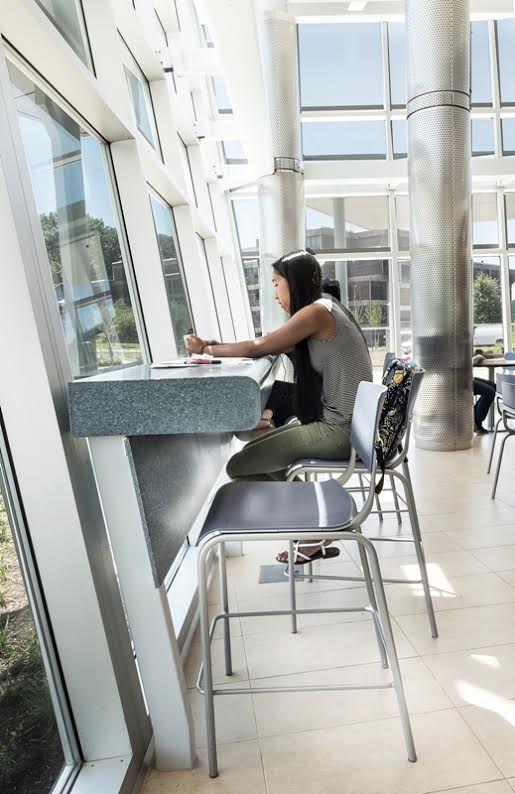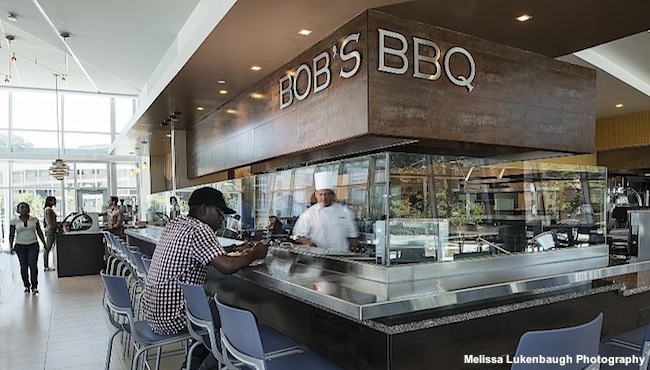Creating a dining experience for the modern millennial requires not only a deep knowledge of good design, but also an understanding of what makes today’s students tick.
KSQ Architects dining specialist Juana Gomez, as well as culinary designers and consultants from Bakergroup and Ricca Newmark, recently provided insights into what trends are transforming the campus table.
1. Food is community
Sure, some students simply want to eat in peace–and creating bar height spaces where they can feel comfortable dining alone is key. But because family is increasingly important to the millennial generation, many students prefer the communal act of dining with others. This shared experience gives birth to community and raises the level of engagement on campus.
In fact, a survey of 1,000 millennials by marketing agency BBDO Atlanta found that “48% said their families define them, and 16% said their passions do. Honesty ranked highest in what matters most in how they live their lives. Pretentions are out. Honesty and transparency are in. And, integral to their lifestyle is the food they eat and the people they eat it with.” Flexible spaces that support any given mood–whether solitary or communal–are key to any successful student dining project.
2. Restaurant, not cafeteria
Dining halls today are not the cafeterias of yesterday. Today’s students want a more retail experience and they want variety–and ideally multiple choices of fresh foods prepared right in front of them and to their specifications. In fact, the BBDO survey also found that nearly five out of 10 millennials refer to themselves as foodies. Sophisticated yet durable finishes, comfortable lighting and seating, and inviting spaces to simply hang out whether they’re hungry or not.
“Dining on campus is evolving more into commercial restaurants and farther away from the “stainless” cafeterias of my collegiate days. Instead of “dining halls” we are going to “mini-restaurants” and “marketplaces,” says Tom Ricca, founder of culinary design firm Ricca Newmark. “Student dining rooms today are furnished with upholstered booths and banquettes with highly designed ceilings and lighting.”
3. Connection to the outdoors

Photo credit: Melissa Lukenbaugh Photography, courtesy of KSQ Architects
Whether it’s an indoor space flooded with natural light or a true al fresco dining experience, students crave sunlight as much as a slice ofpizza. Nothing raises the mood, inspires conversation and communicates hospitality like a wall of windows or a patio full of tables.
“Especially in climates that are more temperate, we like to provide spaces that allow students to take the dining experience outside,” says KSQ associate and dining specialist Juana Gomez. "Having options is vitally important to students today, and al fresco dining–with a variety of seating choices–really lets millennials create what feels like a customized eating experience.”
4. Food origins
Not only do 21st century college students think differently about food than any previous generation, they also care deeply about the origins of their food–whether the emphasis is on how it’s grown, where it’s grown or who grew it, the ethical factors that come into play are increasingly important to this new generation.
“Students are also seeking more transparency and authenticity in the preparation of their food, reflected in the popularity of exposition cooking and artisan foods, and in the demand for fresh ingredients,” says Jim Sukenik, president of food service consultant Bakergroup. “A movement toward local food sourcing is a driver of chef-driven menus that frequently change, based upon the seasonal availability of some items.”
5. Spaces with flex appeal
Let’s face it–today’s millennial is easily bored. Finding ways to keep a dining hall ever new is a challenge that can be achieved with revolving art exhibits, new music, updated menus and branding opportunities. Keeping the experience fresh is a key factor in making dining a place that pulls kids from all corners of campus.
“Like a storefront window, the dining hall ideally has something new going on all the time,” says KSQ’s Gomez. “Often a small stage–for students to play music, have poetry readings or do improv–can be a big attraction.”
6. Convenience, always
A recent article by physicians with the Mayo Clinic noted that trends indicate 35% of meals eaten by millennials are actually snacks. Which means the portion sizes and dining hours need to be flexible. Whether it’s hours of operation or locations on campus, students tell us they want convenience and choice. Dining in with friends, grab-and-go on the way to class or delivery are also options students look for to make their hectic life a little easier.
“Convenience is paramount – foods that students want, where and when they want them,” says Sukenik. “Fresh, local, and healthy ingredients; smaller portion sizes; snacking and grazing in lieu of full meals, and “trading plates” are growing trends.” Tom Ricca agrees. “With the mobility of our youth, constantly connected, and time-challenged, we see the need for more and more “portable” foods that can be easily hand-held, packaged and eaten on the move. This would be items like burritos, pasties, and empanadas,” he says.
7. Going global

Photo credit: Melissa Lukenbaugh Photography, courtesy of KSQ Architects
From their own travel experiences to what they’ve seen on YouTube and Food Network, today’s students are far more savvy about ethnic foods, emerging food trends and unique dietary requirements to meet their needs. Students have also gravitated toward specialty beverages including craft teas, local soft drinks and infused water.
“The food itself responds to the ever-increasing sophistication of today’s teenager, who has eaten more meals in restaurants in his/herlifetime than at home, has travelled internationally and has experienced multi-cultural cuisines and cooking techniques from around the globe,” says Ricca. “Gone is the era of pizza, burgers and delis–now we have churrascos, Mongolian BBQ, dim sum and gyros.”
“Gluten-free menu items continue to gain traction, as many give up wheat products for health and lifestyle reasons,” adds Sukenik. “Ancient grains and nuts have become popular alternatives to wheat and meat, though smoked meats and other foods continue to rise in popularity,” he says.
8. Dine in, plug in

Photo credit: Melissa Lukenbaugh Photography, courtesy of KSQ Architects
Technology doesn’t stop with the lunch hour. In fact, for many students, the dining experience always includes either a smart phone, laptop or flatscreen TV. More than one-third of respondents to the BBDO survey said they like tech perks in dining venues, including ordering on iPads and pre-orderings with smart phones. Ironically, while 88% said they look at their phones while eating, 44% said they dislike it when their friends do.
Today’s dining halls feature seamless integration of technology, with power outlets built into furnishings, WiFi access (67% in the BBDO survey said they want free WiFi in restaurants) and digital connections to nutritional information, menus, surveys and even suggestion “boxes.” Walls with large-format televisions allow for communal TV or movie viewing and even the occasional video game tournament.
“Students today want to stay connected, even when they’re dining,” says KSQ’s Gomez. “Even if a dining hall doesn’t feature televisions, kids are looking at their phones. It’s a reality our designs must support—this is a generation that views their smartphone as a physical extension."
Related Stories
| May 18, 2011
Raphael Viñoly’s serpentine-shaped building snakes up San Francisco hillside
The hillside location for the Ray and Dagmar Dolby Regeneration Medicine building at the University of California, San Francisco, presented a challenge to the Building Team of Raphael Viñoly, SmithGroup, DPR Construction, and Forell/Elsesser Engineers. The 660-foot-long serpentine-shaped building sits on a structural framework 40 to 70 feet off the ground to accommodate the hillside’s steep 60-degree slope.
| May 18, 2011
One of Delaware’s largest high schools seeks LEED for Schools designation
The $82 million, 280,000-sf Dover (Del.) High School will have capacity for 1,800 students and feature a 900-seat theater, a 2,500-seat gymnasium, and a 5,000-seat football stadium.
| May 17, 2011
Sustainability tops the syllabus at net-zero energy school in Texas
Texas-based firm Corgan designed the 152,200-sf Lady Bird Johnson Middle School in Irving, Texas, with the goal of creating the largest net-zero educational facility in the nation, and the first in the state. The facility is expected to use 50% less energy than a standard school.
| May 16, 2011
USGBC and AIA unveil report for greening K-12 schools
The U.S. Green Building Council and the American Institute of Architects unveiled "Local Leaders in Sustainability: A Special Report from Sundance," which outlines a five-point national action plan that mayors and local leaders can use as a framework to develop and implement green schools initiatives.
| May 10, 2011
Greenest buildings: K-12 and commercial markets
Can you name the nation’s greenest K-12 school? How about the greenest commercial building? If you drew a blank, don’t worry because our friends at EarthTechling have all the information on those two projects. Check out the Hawai’i Preparatory Academy’s Energy Lab on the Big Island and Cascadia Green Building Council’s new Seattle headquarters.
| Apr 12, 2011
College of New Jersey facility will teach teachers how to teach
The College of New Jersey broke ground on its 79,000-sf School of Education building in Ewing, N.J.
| Mar 15, 2011
What Starbucks taught us about redesigning college campuses
Equating education with a cup of coffee might seem like a stretch, but your choice of college, much like your choice of coffee, says something about the ability of a brand to transform your day. When Perkins + Will was offered the chance to help re-think the learning spaces of Miami Dade College, we started by thinking about how our choice of morning coffee has changed over the years, and how we could apply those lessons to education.
| Mar 15, 2011
Passive Strategies for Building Healthy Schools, An AIA/CES Discovery Course
With the downturn in the economy and the crash in residential property values, school districts across the country that depend primarily on property tax revenue are struggling to make ends meet, while fulfilling the demand for classrooms and other facilities.
| Mar 11, 2011
Oregon childhood center designed at child-friendly scale
Design of the Early Childhood Center at Mt. Hood Community College in Gresham, Ore., focused on a achieving a child-friendly scale and providing outdoor learning environments.















